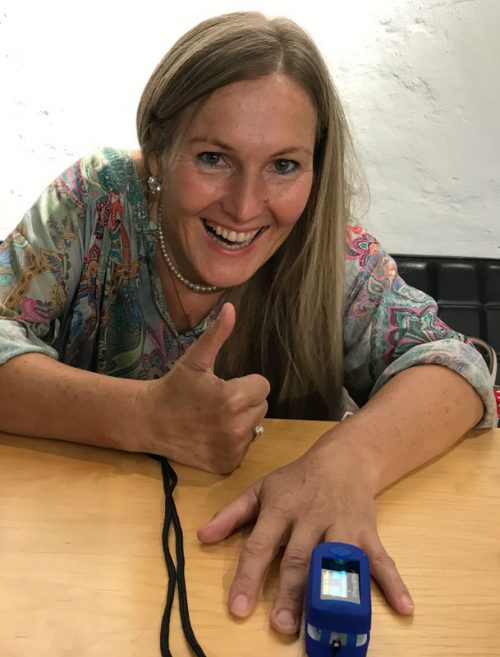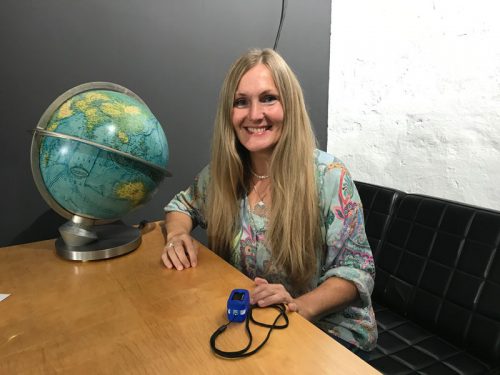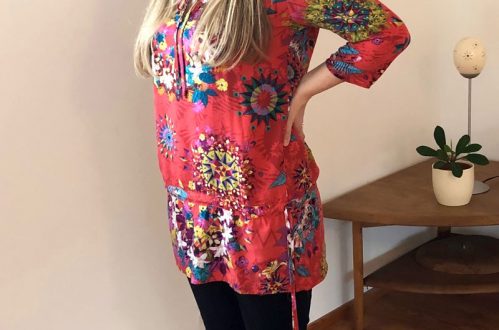With her breathing and singing concept she also accompanies cystic patients.
Eveline Skarek is an art therapist and singing teacher. She primarily supports people with lung diseases, such as asthma, COPD or cystic fibrosis and provides them with a unique concept that combines special breathing training and simple singing. She leads a choir for singing people with lung disease, and sings passionately herself in her jazz band “SAY YES & keep swinging. The dedicated singer was a guest at ATMOS.
ATMOS: Dear Eveline Skarek, ATMOS and you are connected by what we do and work against lung diseases. You are close to people and have made your passion, singing, your profession in many ways. You are the director of the Institute for Art and Singing Therapy. How did this come about?
Eveline Skarek: History finds its origin in Weyer. At a Christmas party in the rehabilitation center, the then director Prim. Dr. Alfred Lichtenschopf got the inspiration for it while singing Christmas carols. One of his employees, to whom I gave singing lessons, recommended me and then we already worked on the concept. For almost 10 years now, breathing and singing therapy has been an integral part of therapy at the Rehazentrum Weyer.
I also work in Amstetten with a free group with lung specialist Dr. Alexander Huber. Together with him I also run the Institute for Art and Singing Therapy “Breathing consciously * Singing simply * Living better”.

The oxygen saturation is also correct during the conversation.
The pulse oximeter provides your clients with a first aha effect about the positive effects of the exercises.
ATMOS: What is special about the concept in rehabilitation?
Eveline Skarek: We combine exercises from respiratory physiotherapy with vocal pedagogy. It was developed with doctors and a physiotherapist and consists of 4 modules. We pick up the clients here on several levels. At the beginning we focus on the physiological processes: What effect does the posture have, what happens in the body during breathing? We back up the practical breathing exercises with scientific facts. The singing together then activates the mental and emotional level of the patient. There is also scientific evidence that singing together has a positive effect on well-being and health. The clients should learn that the regular execution of the “exercises” also brings a lasting change after the rehabilitation. The quality of life, performance and mobility of the people should increase – these are our goals.
ATMOS: Sounds like an effective combination, which is certainly a relief and joy for many. The ATMOS resort should also be a place that emphasizes life and not illness. Is singing a thing for everyone?
Eveline Skarek: (disguises the voice) “I will definitely not sing! (laughs) – I am often “greeted” by some patients in rehab when I come in. But that leaves me unimpressed in the meantime, because I know that they will also get involved. Often the transition from breathing exercises to singing is so smooth that you don’t even notice it. In the end, everyone is always there with heart and soul. And: They notice that it does you good and therefore they like to do it. Everyone who has a speaking voice can sing in a certain way!
I am convinced of this and my clients are also convinced by what I do. Some so much so that they have founded their own choir, the “Easy Breathy Singers Austria”. The choir for singing people with lung disease. I send out online practice videos and the lyrics of the songs, and organize performances. We practice at home and in therapy groups from Vienna, Eisenstadt, St. Pölten, Amstetten to Linz. Real rehearsals with the whole choir are hardly possible. We have participants from Mattighofen to Graz, some are not very mobile. We usually only meet at the performances, and the personal meeting is a particularly joyful highlight for everyone.
Anyone who has a speaking voice can also sing in a certain way! I am convinced of this and my clients are also convinced by what I do.

ATMOS: Are there also people who were infected with COVID-19 in your therapeutic environment?
Eveline Skarek: Yes, two of them, whom I have accompanied during a therapy before. Both were pre-sick. One client with COPD, one client with a lung carcinoma, who was operated on 5 years ago. They both survived COVID-19 disease. I had a conversation with Sepp, the COPD client, some time ago and he says that the exercises he learned in rehab helped him a lot over time and that they contributed to a faster recovery. The lady with the operated lung carcinoma is also in our choir. The course was worse, but she made it! When she was back home, the choir surprised her with a serenade from the garden. That was very touching.
ATMOS: Thank you for this personal insight. These are also valuable mood pictures for the currently omnipresent corona virus. Another excursion into art therapy. How does that fit in with the singing part?
Eveline Skarek: Some people are accompanied by other topics besides their illness that “take their breath away”. Art therapy is a useful addition for those who want to work on them. These topics are worked on in individual lessons.
ATMOS: Thank you, dear Eveline Skarek, for your commitment and work. We are looking forward to further conversations and to an intensive exchange also about the ATMOS Selfness Resort.
An inhalation exercise
The full breathing of professional singers also helps with lung diseases. A basic distinction is made between inhalation and exhalation exercises. The presented exercise is an inhalation exercise that activates the full potential of the ‘inner air space’.
1. abdominal/diaphragmatic breathing
During full breathing, the air flows “into the abdomen” during phase 1 inhalation, but more precisely in the lower regions of the lungs towards the diaphragm. The abdomen bulges forward a little.
2. flank breathing
In the second phase, the air flows “into the flanks” and thus widens the lower front and lateral costal arch. The lower ribs move slightly outwards.
3. chest breathing/high breathing
In the third phase, the air flows “into the chest” and thus widens the middle and upper regions of the chest. The ribcage rises.
The sequence of these inhalation phases is essential for success.
It is helpful if the hands are placed on the respective region so that the movement of the abdomen, flanks and chest can be felt and controlled well. The inhalation air should flow fluently through these three phases. This exercise can be performed with nasal breathing or mouth breathing. A deep exhalation follows through singing or conscious breathing exercises. Afterwards the inhalation in the phases of full breathing again.

Around the world. Your contacts reach as far as New York. In June Eveline Skarek gave an interview for ‘Strong Island TV’ with the NY Paradise Studios.
Eveline Skarek, born 14.7.1968 is
- since 3 years director of the Institute for Art and Voice Therapy Founded in 2017
- since 5 years Dipl. Instrumental- and Vocal Pedagogue, VMI – Vienna Music Institute, private conservatory with public rights
Diploma with distinction 2015 - has been working as an art therapist for 15 years, Diploma 2016, ÖAGG – Austrian Working Group for Group Therapy and Group Dynamics
- for 20 years jazz singer with SAY YES & keep swinging, VMI – Vienna Music Institut, private conservatory with public rights
Diploma with good success 2015 - for almost 30 years Dipl. Sozialarbeiterin, Federal Academy for Social Work St. Pölten / now University of Applied Sciences, Diploma with distinction 1991






